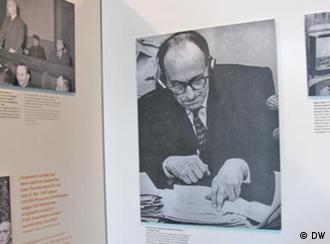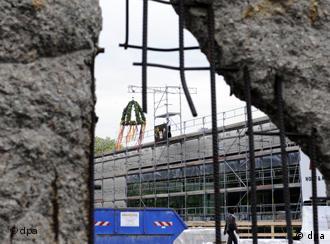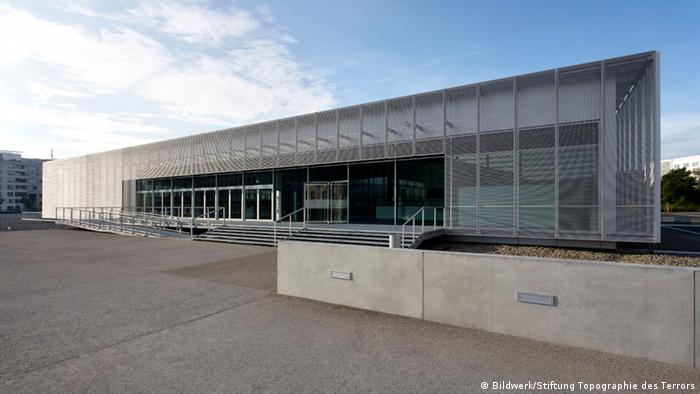Here were the desks at which the Holocaust was organized, and atrocities were planned. The Topography of Terror Documentation Center looks back over 25 years with an exhibition which asks how it happened.
The sun sinks slowly on the horizon. A man and a woman sit on two stools directly above the excavated cellar where meals were once cooked for SS officers. "There are just too many Jews, you know. Eleven million in Europe, three million in Ukraine alone," says the woman. "We can't just shoot them all," the man replies, scrolling through his script.
The shocking exchange is an excerpt from Jonathan Littell's novel "The Kindly Ones," which details the history of National Socialism through the eyes of one of the perpetrators. The actors at Berlin's Maxim Gorki Theater are reading excerpts from the book. Letters and diaries written by Holocaust victims are also being quoted. The stage is the Topography of Terror Documentation Center in Berlin.

Actors from Berlin's Maxim Gorki Theater read excerpts from "The Kindly Ones"
Center of horror
The site is sober. The broad, flat plane is nightmarishly bleak, covered as it is with dark, crushed stones. The Gestapo headquarters were based here from 1934 to 1945, along with the SS leadership, the security services and the Office for National Security.
"It was no coincidence that the Nazi regime chose this central location and not barracks on the outskirts of the city," explained Andreas Nachama, director of the Topography of Terror Foundation. "The atrocities were to take place in full view" as a way of counteracting resistance and terrifying critics, he added.
Today, the documentation center lies exactly between two central sites dedicated to the victims of National Socialism: the Holocaust Memorial to the Murdered Jews of Europe and the Jewish Museum. The main aim of the Topography of Terror is to provide an answer to the question of how it was possible for a democracy to become a totalitarian state within such a short period of time. How did the Nazis plan it all and how did they manage to eliminate their political opponents so quickly?

Perpetrators such as Adolf Eichmann planned the Holocaust from behind their desks
Murder from behind a desk
The exhibition offers insight into the apparatus of terror. It illustrates how perpetrators such as Heinrich Himmler, Reinhard Heydrich or Adolf Eichmann planned and administrated the Holocaust from their office chairs. The horrific fate of six million Jews, Sinti, Roma and political prisoners was decided here - decisions concerning deportation, life and death.
Today, only a metal outline marks the place where the main Gestapo prison once stood. Some 15,000 political prisoners passed through its corridors, en route to interrogation or torture. Edith Walz, who was arrested by the Nazis for distributing flyers promoting the socialist Young Workers movement, was among the prisoners and her recollections were recorded, and are read aloud: "They led me past battered faces. And then the Gestapo man said to me, 'You're still young. But if you're not reasonable, you'll soon look like they do.'"
Wall of silence
For a long time, the city of Berlin and the rest of Germany suppressed this place from collective memory. Everything that wasn't destroyed by bombs during the war was demolished afterward. The site remained an urban wasteland directly behind the Wall on the western side. A motor-racing circuit was erected there where Berliners could amuse themselves for a time. In 1987, a civil initiative was launched to excavate the foundations and open a provisional open-air exhibition.
The documentation center first opened in 2010. The opening was postponed on multiple occasions due to unresolved issues regarding who had overall responsibility for the site. A spectacular design for the building by Swiss architect Peter Zumthor came to nothing after years of back and forth. Technical problems and limited financial resources were to blame.

The Topography of Terror is part of a continual process of coming to terms with the past
Biographies of perpetrators
Today, the Topography of Terror draws around 80,000 visitors each year, many of them tourists and young people. They're especially interested in the structures of the Nazi regime and the biographies of the perpetrators. Many are surprised to learn just how young a large proportion of Nazi perpetrators were.
"The image one has of the Nazi war crimes trials is generally that of old men. But back then they were relatively young," said Andreas Nachama.
They were young, optimistic and thoroughly aware of their actions. In one of the numerous black-and-white photographs at the documentation center, cheerful female SS assistants can be seen - in Nazi jargon "SS maidens." They are pictured enjoying themselves with their uniformed male colleagues on a jovial work outing. It was a break from their work at the Auschwitz concentration camp.
The chilling photograph was probably taken in 1944. It shocks with the retrospective knowledge of the atrocities carried out by the carefree looking people captured in the image.

Around 80,000 visitors tour the site in the center of Berlin each year
Learning from history
But the exhibition not only concentrates on the past. "Today it tells us what can happen in a country in which the justice system is not independently held to account," explained Andreas Nachama. "Visitors can ask, what is the situation like for me today?"
Most recently, protests in the Arab World have shown how that question is more relevant than ever. And there are parallels to countries such as Argentina, Chile or South Africa, which have also suffered under state terror.
A Japanese visitor explained just how important the site was for her. "We don't remember history in Japan. It is not talked about."
The public who have come to listen to the reading hesitate to applaud. Is it appropriate to applaud the reading of a Nazi decree? There's no answer to that. And so a ruminative silence falls over hesitant applause.
Author: Bettina Kolb / hw
Editor: Kate Bowen dw de
Editor: Kate Bowen dw de

No comments:
Post a Comment